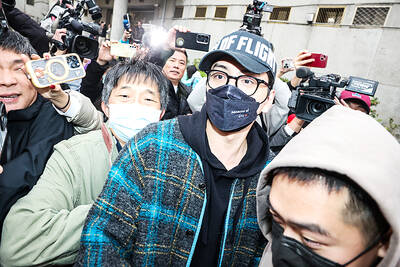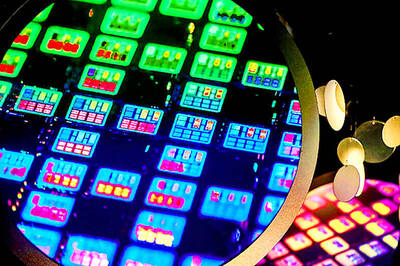An exhibition of more than a dozen artworks by a Taiwanese-based Indian artist and inspired by ancient cave sculptures opened on Friday at India’s representative office in Taipei.
The “Into the Caves of India” exhibition, which ends on Friday next week, features 15 mixed media artworks by Taipei-based Vandana Mengane at the India-Taipei Association.
Among the artworks is a 77cm-by-63cm mixed media piece titled Trimurthi, which depicts the deities Brahma, Vishnu and Shiva. The artwork is intended to draw visitors deeper into the exhibition
Mengane presents Vishnu as an energy that manages the universe, while 10 of her artworks depict 10 incarnations of Vishnu in the form of animals and people.
“These were all carved in India’s caves thousands of years back,” Mengane said.
Another highlight is a 95cm-by-76.5cm mixed media painting titled Peace is Within, which was inspired by paintings from the Ajanta Caves in the Aurangabad District of India’s Maharashtra state that date back to about 200 BC.
The artwork shows the face of Buddha in a cave with numerous lotus plants in various positions.
“My perception of the lotus is that we start with the bud and when we bend, which is something like removing our ego, we can start our step towards enlightenment,” Mengane said.
When a lotus flower blooms, it is a representation of the enlightenment stage, she said.
Mengane said she has lived in Taiwan since 2017 and “Into the Caves of India” is her fifth exhibition in the nation.
She is also the founder of the platform Anahata Artisan, which aims to connect artists from rural India to art lovers in Taiwan.

Actor Darren Wang (王大陸) was questioned by prosecutors for allegedly orchestrating an attack on a taxi driver after he was allegedly driven on a longer than necessary route in a car he disliked. The questioning at the New Taipei City District Prosecutors’ Office was ongoing as of press time last night. Police have recommended charges of attempted murder. The legally embattled actor — known for his role in the coming-of-age film Our Times (我的少女時代) — is under a separate investigation for allegedly using fake medical documents to evade mandatory military service. According to local media reports, police said Wang earlier last year ordered a

President William Lai (賴清德) should protect Taiwan Semiconductor Manufacturing Co (TSMC), and stop supporting domestic strife and discord, former president Ma Ying-jeou (馬英九) wrote on Facebook yesterday. US President Donald Trump and TSMC on Monday jointly announced that the company would invest an additional US$100 billion over the next few years to expand its semiconductor manufacturing operations in the US. The TSMC plans have promoted concern in Taiwan that it would effectively lead to the chipmaking giant becoming Americanized. The Lai administration lacks tangible policies to address concerns that Taiwan might follow in Ukraine’s footsteps, Ma wrote. Instead, it seems to think it could

A man in Tainan has been cleared on charges of public insult after giving the middle finger during a road rage incident, as judges deemed the gesture was made “briefly to express negative feelings.” In last week’s ruling at the High Court’s Tainan branch, judges acquitted a driver, surnamed Cheng (程), for an incident along Tainan’s Nanmen Road in September 2023, when Cheng had spotted a place to park his car in an adjacent lane. Cheng slowed down his vehicle to go into reverse, to back into the parking spot, but the car behind followed too closely, as its driver thought Cheng

DEFENSE: The purpose of the exercises is to identify strategies for the government to control risks during tensions, prevent war and bolster national resilience A tabletop exercise series has begun simulating possible scenarios if the Chinese People’s Liberation Army (PLA) launched a war against Taiwan in the guise of a military exercise. The exercise series is jointly organized by National Chengchi University’s Institute of International Relations, Taiwan Center for Security Studies and Asia-Pacific Policy Research Association. Chinese Nationalist Party (KMT) Legislator Chen Yeong-kang (陳永康), former American Institute in Taiwan (AIT) director William Stanton and Taiwan Center for Security Studies director Liu Fu-kuo (劉復國) attended the event in Taipei yesterday. Scenarios that would be simulated include changing political circumstances in the US during US President Donald Trump’s tenure